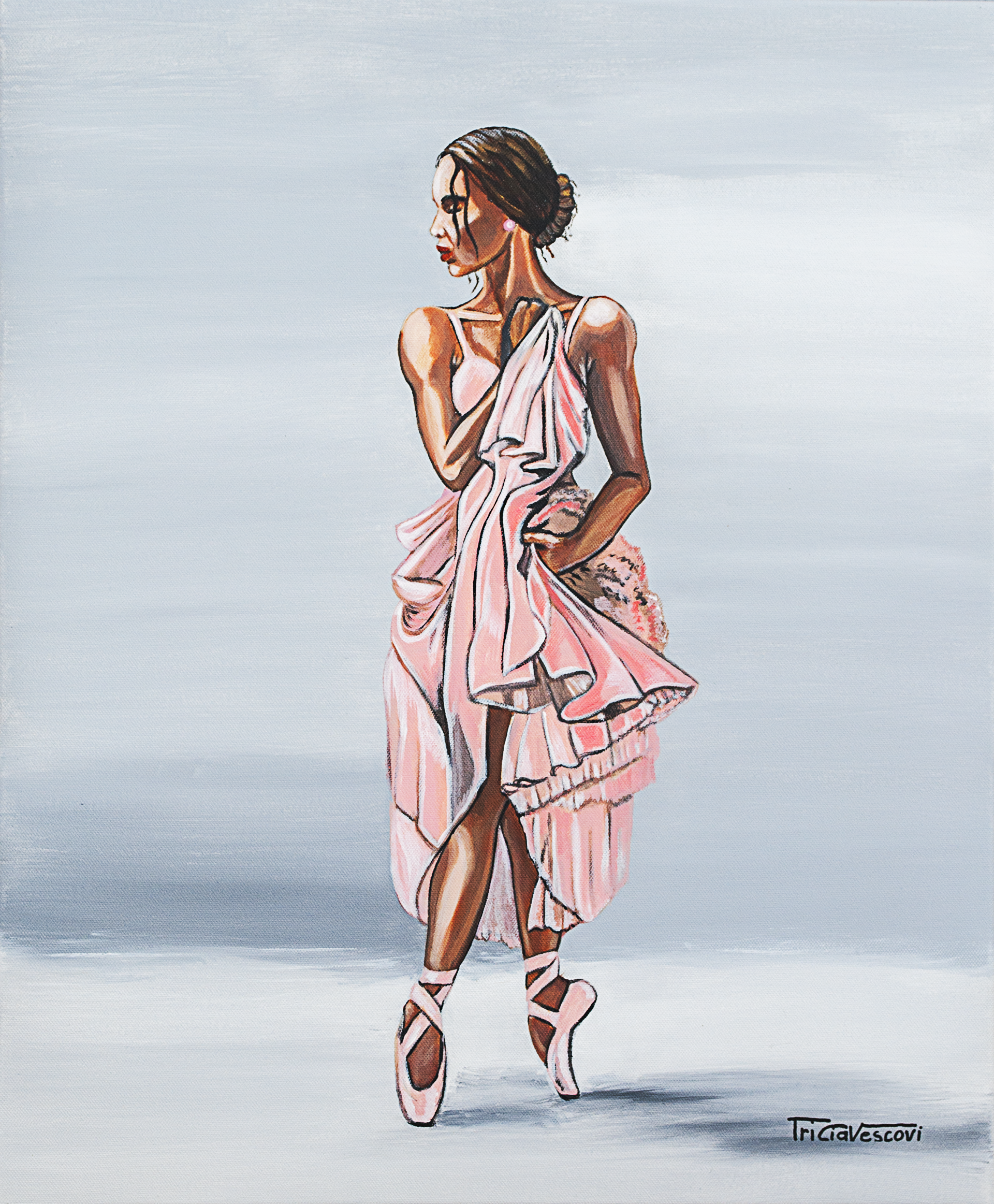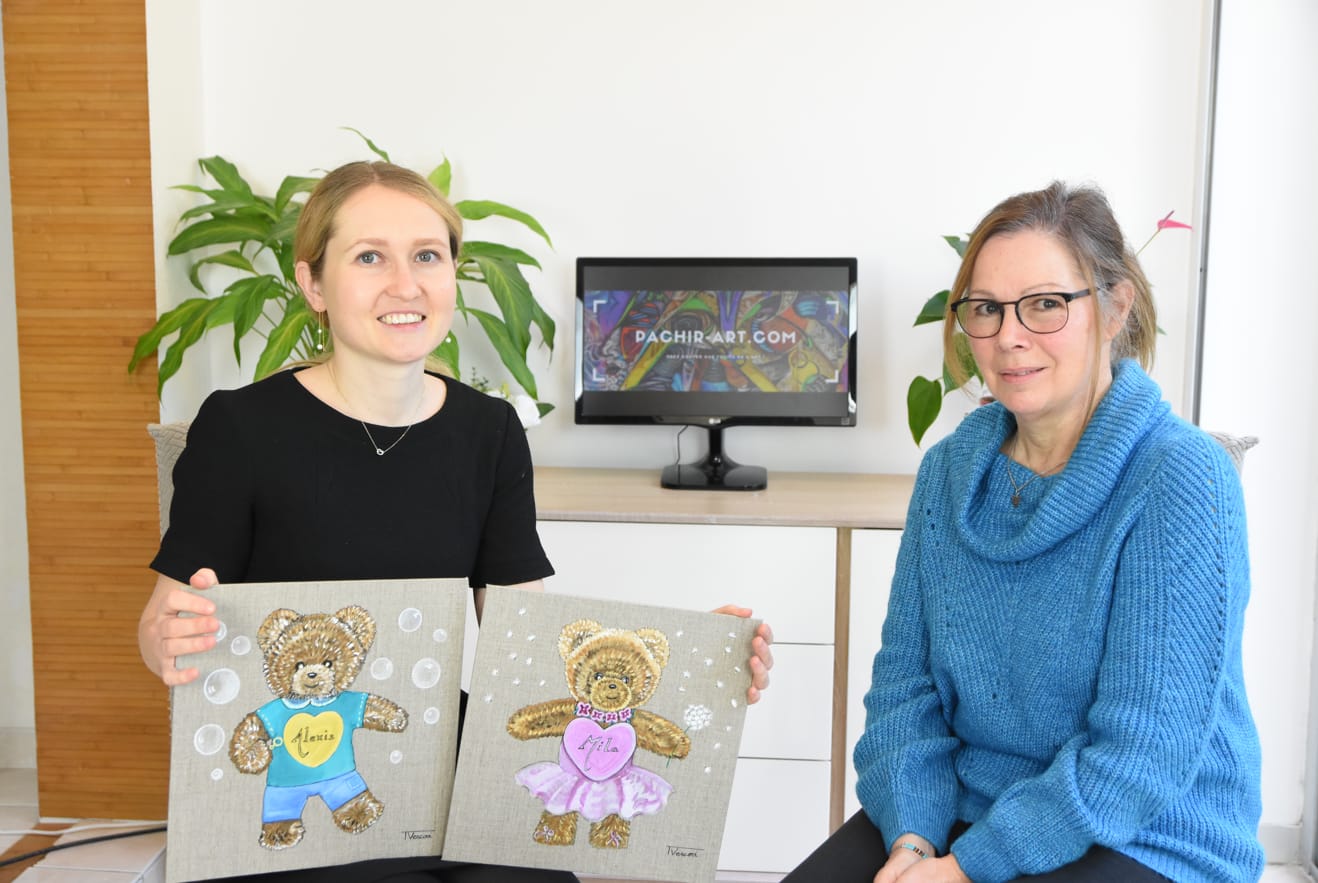Interview with Tricia Vescovi
Introduction Olga :
Hello to all art lovers ! It is with great pleasure that I introduce to you today our talented painter Pachir’art: Patricia Vescovi aka “Tricia”. I thank her for accepting my invitation to answer a few questions in order to know a little more about her history as a painter.
Olga : Hello Patricia
Tricia : Hello Olga
Olga : How did you get started and what triggered your interest?
Tricia : Well, starting is a big word, starting. Let’s just say that I’ve always loved drawing, I’ve been drawing since I was 4 years old. It’s a bit of a refuge for me in times of… When I was little, it was my refuge in times of hardship, because I had a difficult childhood with the atmosphere at home, so it wasn’t easy. And it’s true that drawing has always been a positive thing for me, or in the end I was master of what I did, I didn’t suffer anything, I created, and it’s true that since the age of 4 it’s always been my passion. Well, as the years went by, there was school and all that. I always doodled, as I was looking after children I did a lot of drawings for them and then time went by, it was finally 21 years ago that I really started to do paintings, following a misfortune and a chance at the same time, I had a serious illness, so I said to myself that I had to live from my passion. And I put myself into it, that’s all. Well, I painted a lot for the family at the beginning, for years and years, and they pushed me, pushed me so that I could make my work known a little… she says smiling
Olga : Thank you very much – what is your style, what paint do you use ?
Tricia : Well, the paint is acrylic paint, but I painted for a long time with oil paint, it was a real pleasure! But the smell was terrible, it gave me headaches, so I said I had to move on. I had a hard time getting into acrylics because it’s not the same work, oil is more slippery, more melted, you could say. But otherwise, now with acrylics, I really enjoy it.
So my style is between portraiture and realism. Yes, I think that’s it, a little bit the things that upset me, we’ll say.
Olga : Great! You’ve been painting for more than 20 years now, how has your painting evolved, have there been any important steps ?
Tricia : Yes, because at the beginning when I painted it was very childish compared to now, drawing was fine but putting layers of paint on it was difficult, because when you haven’t learned, it’s not easy. So the first paintings, my daughter was very happy that I gave them to her, but then I threw them in the bin because frankly it was really… (laughs)
Olga : You weren’t happy
Tricia: Oh no, no! It’s true that when you compare… Fortunately, I improved anyway
Olga: Patricia, what are your sources of inspiration? Maybe you have an artist who inspires you?
Tricia : Not especially, no. When I go to museums, I look at all the painters and I like certain paintings. There might be one by an artist that I like, and then one by another artist. I don’t go by artist, I go by love, so the range is wide. As long as it’s not abstract, many artists inspire me. Older artists. Well, for example Picasso, when I discovered Picasso, I didn’t like what he was doing at all, but I didn’t know his pink period. And his pink period, I found it magnificent, because there it was a lot of faces and everyday life. So yes, I could say Picasso “pink period”.
Olga : And what are your sources of inspiration generally ?
Tricia : My sources of inspiration are often when I look at photos, well it’s true that I’m looking for beautiful faces, photos that make me fall in love with them and what’s terrible is that sometimes I’d like to have cameras in my eyes to be able to photograph people in the street, because as soon as I see an African lady I… (shivers)
Olga : it’s the heart that beats (laughs)
Tricia : oh yes, it upsets me, because I find them so beautiful! I just can’t get enough of them !


Olga : Okay, thank you very much ! Now I would like to talk about your paintings. Patricia, tell us about your best works for Pachir’art
Tricia : Well, there are… At times I had a crush on some of my paintings, but when I look at all my paintings, one that I really miss, because there’s one that I really miss on my wall is “Les amants de Saturne”. The lovers of Saturn, well, why this name, because first of all Saturn, you mustn’t forget that it’s the planet that means Saturday, we often dance on Saturday, so for me it’s… already the name comes from there. Otherwise the couple, for me it is something important, I wanted to represent the woman completely in confidence with the man. He supports her. Well, the man is normally the force, but there is a lot of softness here. There is the grace of the dancers and I wanted to represent passion and harmony.
The naiad with the pearl, I wanted to represent in the water, because water is life. I took a lot of pleasure in making her face, I didn’t realise it at the beginning but when I started to insist on the look, it’s true that I had the impression that it was a bit like my daughter’s look and it’s especially my entourage that made me see that it was almost the face of my daughter. So it’s true that this painting is important to me, because it reminds me of my daughter. And it’s the sweetness, it’s the grace. That’s what I always revolve around (laughs).
So, field of love, why that name ? Because among the Zimbas, the mother, before birth, chooses a song that she will whisper throughout the child’s life, to comfort him in difficult moments. And even in adulthood, the whole tribe continues to sing this song to encourage the child. That’s why I put this song there. There is the mother’s look on the child, there is the protection. I wanted to put a very soft carpet because the baby needs softness and I especially wanted to show motherly love and trust.
Olga : Thank you very much Patricia for your explanations, so that we know a little more about what is behind your works of art.
About your series of dancers, I personally love your painting “Vol”: the colours, the gestures, the grace of this ballerina are just incredible. We notice that dance is an important subject for you. Can you tell us more about it?
Tricia : Yes, it’s true that I would have liked to do classical dance since I was a child, but it wasn’t the case because it’s not easy, parents don’t necessarily listen to their children. My best friend used to do ballet, and then I saw a series on television which was magnificent, which was about dance, it was “Les jours heureux”. So my two daughters I made them do ballet
(Laughs)
They were delighted and so was I
Laughs
And it’s true that for me it’s grace, softness, beauty
Olga : Yes, it’s very pretty! Where does this love for Africa come from ?
Tricia : Well, the love for Africa is a very simple thing, I was ordering coffee… Toy Factor (3:22) sent me a very large diary on Africa, all the places where they were going to get coffee, and I really fell in love with everything about their lives, their homes, the way they live with their children, the fathers, the mothers… family life, African family life. So that was really the heartbeat. For me it was really the trigger for Africa. So beautiful (laughs)
Olga : In your paintings, we see a lot of African women, sometimes naked with beautiful shapes, sometimes with babies. Tell us their stories.
Tricia : So for me their story… Well it’s true that I went a little… I went a little deeper to see how they lived and I find that it’s so natural the love they have even in their tribe how it happens is beautiful, even if it’s just a mother the way she cleans her child. It has nothing to do with us, it’s really natural, it’s beautiful. Everything is natural with them. It’s really beautiful.
Olga : Patricia, you have had a difficult, sometimes painful life. And despite everything you have managed to overcome all the trials. We can see that painting has been for you like a spare wheel, your refuge to express your feelings and emotions in your works. What does this mean to you ?
Tricia : For me, when I paint, I can express myself fully. It’s also a moment of relaxation, of passion, because it’s passion. And for me it’s true that if I didn’t have painting, I think I’d be much more stressed and it’s true that to create works of art under the brush… I’m not going to say works of art because that would be estimating myself very, very high. (laughs) but it’s true that the faces that are born under the brush, we give life and for me that’s the pleasure of giving life.
Olga : And to share with others
Tricia : Yes, absolutely, and to see how each person feels too. Because there is already the feeling of all those around me, my whole family. And then there’s the feeling of people who don’t know me and who say nice things about me. And that’s important, because it’s true that compliments help you to progress.
Olga : Thank you very much Patricia, thank you very much for your paintings, everything you share with us because it is very important. Thank you very much for sharing your story with us today.
Tricia : Thank you too Olga
Discover all the works of Tricia
🎨 Find us on our Facebook, Instagram



